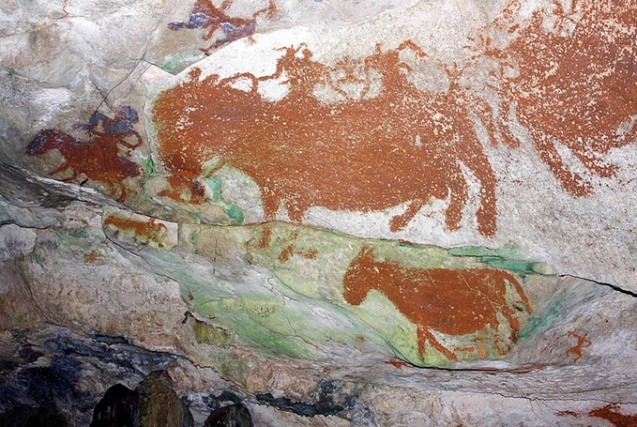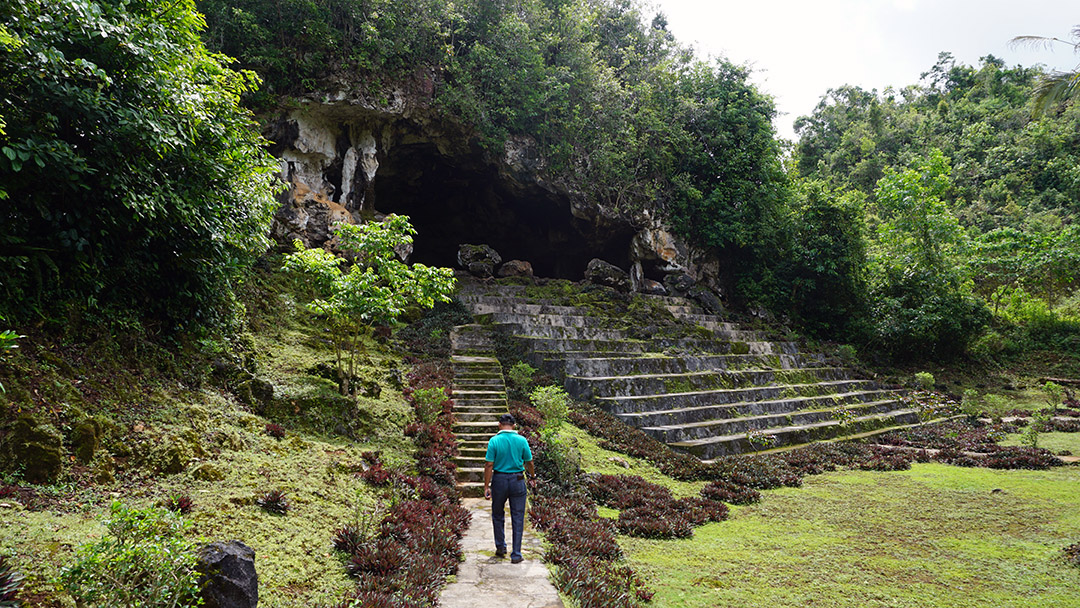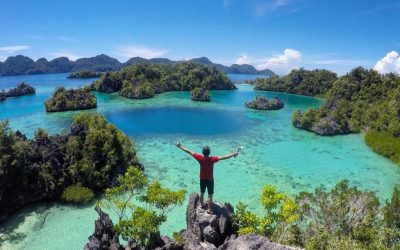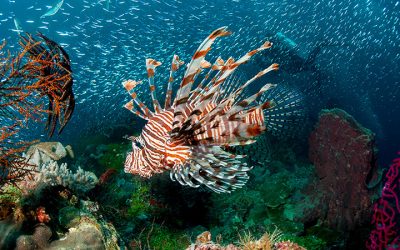Cultural Destination
Kobori Cave
Kobori Cave (Photo: @Indonesia Tourism)
Kobori Cave
A little bit of history is always needed to understand the place you are visiting. The Kobori Cave represents a concrete testimony of the ancient Muna Tribe in Megalithic era (around 4000 BC). This Indonesian National Heritage Site is also known as the “the cave of ink” for the fact that visitors who enjoy an excursion here, can witness some very old paintings which describes the way of life of this tribe. There are 565 megalithic paintings spread in several karst cave across Muna island, Southeast Sulawesi. Come and discover this wonderful place!
Cultural Tourism Destination
Kobori Cave
Tourist Attractions in Southeast Sulawesi
Labengki Island – Giant Clam Marine Reserve
No one knows that the second biggest Kima giant clam (Tridacna gigas) with the size of 50 cm can be found in
Bajo Coastal Village in Bokori Island
Located not far from Kendari City, this small island with white sand is a-must-visit in
Wakatobi UNESCO Biosphere Marine Reserve
Known as marine paradise, Wakatobi was designated as UNESCO marine biosphere in
Southeast Sulawesi
Batik Motifs
Wakatobi
It symbolizes the coastal beauty of the Wakatobi island and the symbol of Patra symbolizes
Ake Patra
Ake is related to the divinity and the composition of the universe. It is a symbol of
Pati-Pati Pinehiku
It symbolizes the hierarchy in society and the social status of the Mekongga
Discover
Indonesian
Batik
Motifs
Daun Sirih
This motif illustrates betel leaves that are used by Lombok communities as traditional
Kain Cual
Cual textile tradition has existed since the 17th century. The word “Cual” refers to
Tampuk Manggis Sasirangan
The motif illustrates the philosophy of the mangosteen fruit, which is
Srimanganti
The name of the Srimanganti motif is derived from Palace’s hallway that connects to
Pohon Hayat (Tree of Life)
The Batik motifs in Lampung are dominated by the acculturation of Buddhist and
Taiganja
Taiganja is a precious gold pendant that shows the social status of the Kaili family. It is
Pinawetengan
The Pinawetengan Batik pattern was taken from a prehistoric inscription in
Cengkeh
The clove flower motif is the main commodity of the Tolitoli Regency. This motif represents
Ake Patra
Ake is related to the divinity and the composition of the universe. It is a symbol of
Honai
The Honai is inspired by the traditional house of the Papuan community living in
Singayaksa
The Singayaksa motif comes from the name of a place where Sultan Hasanuddin used to
Gorga Simeol-Meol
The Gorga Simeol-meol is a pattern of plant tendrils. it is regarded as a symbol of longevity and
Parang Rusak
Another meaning behind this motif is an unconquerable spirit, symbolized by
Enggang Dayak
Local people beliefs that hornbills are an incarnation of the Commander of the Birds. It has supernatural
Kaharingan
The Kaharingan or ‘tree of life’ based on the Dayak tribes’ belief system. This tree symbolizes
Jumputan Bintang
The word Jumputan means the tie-dye technique, while the word “Bintang” refers to
Bomba Mawar
This motif means sacred love for family, kingdom, and God; It also illustrates
Gedhog Kembang Waluh
a combination of Javanese cultural motif of the Majapahit kingdom (XII-XIV century) with
Kawung
The Kawung motif was created by Sultan Agung Hanyokrokusumo (1593 – 1645) as a symbolic gift for
Kuda Kupang
Horses symbolize wealth. It contains noble values of virtuous characters that bring
Paqbarre Allo
The word “Barre” means round and “Allo” means the sunlight. This motif is interpreted as
Keluak Daun Pakis
The word “Keluak” is a Minang language which means twisted or tangled. The Motif of
Tubo Kelapa
Coconut tree is a symbol of a good character and strong mentality. It illustrates the more success a person, the more
Raja Ampat
Raja Ampat motif represents the marine life at Raja Ampat archipelago in
Pati-Pati Pinehiku
It symbolizes the hierarchy in society and the social status of the Mekongga
Gonggong Beruntun
This motif illustrates that a person should maintain a positive attitude and
Gentala Arasy
Built as high as 80 meters, the tower also highlights the historical side of
Kasih Tak Sampai
‘Kasih Tak Sampai’ is an idiom in the Indonesian language which refers to
Lontara
The Lontara script itself is a typical ancient script of Bugis and Makassar communities. History records that
La Galigo
La Galigo is a literary work of the Buginese Epic that has 300 thousand epic lines. It is considered even
Bekantan Pakis
This motif represents Pakis Haji (Polystichum setiferum), an endemic plant in
Malinau Cultural Festival
You will witness a unique competition that might not be found other than in
Salakanagara
Salakanagara batik motif illustrates the first kingdom in the Betawi land
Biji Kopi
The coffee seeds motif illustrates the pride of local coffee specialities in
Buketan Bali
The Balinese bouquet (Buketan Bali) is a floral arrangement and the name is
Dayak Kamang
Kamang motif is generally found in the Dayak tribe shield because it is believed to
Awan Berarak
Awan Berarak is a combination of Dayak motifs and Malay patterns. The word ‘Awan Berarak’ means the
Ukir Sentani
The Ukir motif is a batik motif that is inspired by various traditional Sentani wood carvings
Tongkonan
Toraja’s traditional house is called Tongkonan. Tongkonan is a place for
Tifa Totobuang
The batik motifs illustrate Maluku’s traditional music instrument called
Gurdo Solo
Gurdo or garuda bird is the mount of the Indian god Vishnu. As the Sun Bird,
Tangerang Herang
Tangerang Herang motif is a symbol of Tangerang city. The Tangerang Herang batik motif consists of
Dayak Taghol
Dayak Taghol has a distinctive style of four curved lines and small dots. This motif represents
Gigi Haruan Lidi
The Gigi Haruan Lidi motif is taken from the name of the cork fish and is a symbol of
Karawo Mahkuta
Mahkuta refers to Gorontalo’s traditional crown. It represents noble characters of
Tikar Natuna
The Tikar Natuna motif is adapted from the traditional making of pandanus mats in
Pucuk Rebung Riau
Pucuk Rebung symbolizes heart determination in achieving goals, good luck, and
Pala Salawaku
This motif illustrates the unique weapons of the Maluku region, namely
Teguh Bersatu
This batik motif shows the strength of the people of Kupang. It also represents a sense of
Sekomandi
Its philosophical meaning is the eternal union which refers to a saying “until death do us part”
Gumin Tambun
Based on Hindu mythology, this motif symbolizes lucks, abundant wealth, and
Mahkota Siger
Siger is the crown of a noblewoman in ancient time. It is a symbol of femininity, strength, and
Sandeq
Sandeq Boat is a symbol of the maritime importance of the West Sulawesi region. The greatness of
Daun Lada Hitam
The black pepper motif represents the main commodity of Bangka Belitung
Wakatobi
It symbolizes the coastal beauty of the Wakatobi island and the symbol of Patra symbolizes
Bultiya
The word ‘Bultiya’ is an acronym of the three major tribes in North Kalimantan, namely
Kaganga Tanah Rejang
If Batik Besurek combines Arabic calligraphy motifs, then the Kaganga batik takes
Parang Seling
Parang Seling or “alternating daggers” is a royal batik motif. It is a feminine variant of
Sido Mulyo
Sidomulyo is one of the classical motifs, which is specifically used for the bride’s costume in
Hiu Taliyasan
Indonesia is also home to the world’s largest fish, the whale shark (Rhincodon typus). Hiu Taliyasan refers to
Burung Bidadari
Bidadari birds are endemic birds in Halmahera. This motif represents an
Pattimura
Pattimura is the name of an Indonesian hero who fought against colonialism in
Jupri Kembang Teh
Kembang Teh illustrates the tendrils of tea plants that grow in the highlands of
Tabir Tanjung
Tanjung flower is a type of Cherry tree flower, which is commonly found in
Leuit Sijimat
This motif reflects the daily activities of the Baduy tribe in Banten. The main ornaments of batik motif consist of:
Rangkiang
The word “Rangkiang” refers to the rice granary in the Minangkabau language. It symbolizes
Manguni Minahasa
Manguni is identified as the symbol of the Minahasa people. Manguni is known as a
Bale Lumbu
This motif signifies the welfare of the ancient Sasak society. Bale also symbolizes the
Besurek Rafflesia
The term “Basurek” refers to a textile that contains letters or inscriptions
Daun Simpor
This motif is inspired by the Simpor plant (Dillenia Suffruticosa) which is a typical
Durian Pecah
Broken Durian motifs depict the foundation of faith. The second half signifies the mastery of
Besurek Rembulan
This batik illustrates praise for God who created the wonderful universe
Bintik Tujuh
The Bintik Tujuh (Seven Dots) motif has 7 white spots and green color gradation as
Lipaq Sabe
Lipaq Saqbe contains a simple geometric classical motif with various flower decorations. This textile is
Gonggong Siput
Gonggong (Strombus Turturella) is one type of sea snail found around
Lok Baintan Floating Market
As you can imagine, the most authentic thing is that you can buy things and even







